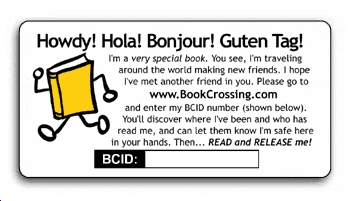Related Categories:New Approaches to Reading Print Texts
Summary:
The Concise Oxford English Dictionary defines bookcrossing as “the practice of leaving a book in a public place to be picked up and read by others, who then do likewise.” BookCrossing’s main principle is that the world should be a book lover’s library. After members finish reading a book and decide they want to share it, they register it for free on BookCrossing.com. This gives each book a unique ID number and an accompanying journal entry on the BookCrossing webpage where the reader can write his/her opinions about the book. The reader then affixes a BookCrossing tag to the book with pertinent information on how another owner can find out about the book’s travels. Finally, the reader “releases it into the wild” (a coffee shop, bus stop, café, etc). Each subsequent reader of a particular book can add to the book’s journal entry on the BookCrossing website, giving his/her opinions and listing where they picked up and dropped off the book.
Description:
BookCrossing touts itself as the “World’s Biggest Free Book Club.” BookCrossing is a website conceived by Ron Hornbaker and internet development firm Humankind Systems, Inc. After viewing PhotoTag.org, which distributes cheap, disposable cameras to “friends and strangers with the request that they take one picture and pass it along to someone else” Hornbaker and his wife realized that nobody had ever tracked books in the same way (PhotoTag.org).

BookCrossing tells its members to follow the 3 Rs: Read, Register, and Release.
BookCrossing wants people’s favorite books to be read by others, so its first tenant is to read books and find some that others will also like. When a member of BookCrossing wishes to release a book “into the wild,” she logs onto the website and registers the book, obtaining a unique BookCrossing Identification Number (BCID). She prints out a tag, writes the BCID number on the book. Doing this gives her book a page on the BookCrossing website. She can choose to write a journal entry for the book that gives her opinions about the book; she can also create “Release Notes” for the book, telling users exactly where she left it. Then she can “give it to a friend, leave it on a park bench, donate it to charity, ‘forget’ it in a coffee shop” or leave it anywhere she wishes. Each time somebody picks up the book, they can search for the book on the BookCrossing website, write another journal entry for the book, and describe where they found the book or what they thought of the book. This process repeats based on how many people add journal entries to the BookCrossing site. The “most-travelled” book on the BookCrossing website is Der selstamme Bücherfreund by Gerard Hoffnung; it has 194 journal entries by various users.
Cafes, coffee shops, and other BookCrossing establishments can be designated as BookCrossing Zones. BookCrossing encourages institutions to become Zones because “besides the obvious goodwill you’ll be generating, BookCrossers who use the Go Hunting feature of our website will come to your place of business just to look for released books, so you should see an increase in traffic.” BookCrossing books with “Release Notes” are in the searchable “Go Hunting” database that charts every location that currently houses any BookCrossing books.
BookCrossing has also started meetups that occur in various establishments. BookCrossing members bring books to these meetups and trade BookCrossing books with each other. Many of BookCrossing’s “most-travelled” books are traded at these meet-ups.
Research Context:
BookCrossing is a research-worthy phenomenon for those interested in distributed systems and those studying online communities. BookCrossing is unique among such projects because it integrates the online world with the “real world” through material objects, meet-ups, and physical locations.
Technical Analysis:
BookCrossing is a simply-designed website that even those with slow internet connections can access. BookCrossing’s labels are available in PDF in many different styles and languages. BookCrossing is notable because it uses existing web technology and older technology (such as book labels) to form a complex interaction between web and print technologies.
Evaluation of Opportunities/Limitations for the Transliteracies Topic:
BookCrossing gives its users a web-forum for exchanges, commenting on, and forming communities around literature. BookCrossing provides an opportunity for researchers to investigate the ways in which print books can serve as a hub to start online communities. While many books are read online, few websites have explored the ways in which books as physical objects can move throughout different physical and virtual locations.
Resources for Further Study:
- Brookman, Rob. “Read and Release: An Online Program Puts Stray Books Up for Adoption.” Book Magazine. (2002): 32.
- —-. “Find This Book! A Group of Guerilla Readers Use Serendipity to Spread Their Love of Literature.” Utne Reader. (Jul/Aug 2002): 83.
- Wood, Christina. “Setting Books Free: Generosity Creates Community.”USA Weekend. 29 Feb 2004.
